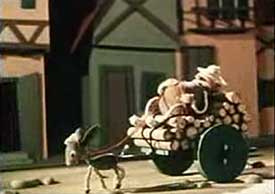 A half-hour stop-motion puppetoon by Karel Zeman, King Lavra (Kral Lavra, 1950) was based on a fairy tale poem by Karel HavlĚcek Borovsky. A half-hour stop-motion puppetoon by Karel Zeman, King Lavra (Kral Lavra, 1950) was based on a fairy tale poem by Karel HavlĚcek Borovsky.
It is deceptively "cute," set in a pre-machine age puppet town, starting off with the mild adventures of a cart driver & his donkey. When the donkey is parted from the driver, it begins braying, & all the mules in the city follow suit, until the cacophony awakens King Lavra asleep in his throne, whose ears are unusually atuned specifically to the sound of jackasses.
Deciding his huge red beard is unruly, a big production is made of presenting the king's scissors to the barber chosen to trim the sovereign beard.
The barber chosen sees the scissors presented to him on a pillow & envisions a chopping block for his own head, as it is customary to kill any barber who wields scissors against the king.
The reason is that the king keeps hidden the fact that he has donkey ears, which by an arrangement of crown & hair he can usually keep disguised. But of course his annual barbering reveals the secret to each barber, whom nobody trusts with the state secret.
The barber has no choice, so comes to the king's call, does a praiseworthy job that the king likes, then is duly marched to the chopping block.
The seasons tick by & the king's beard has again grown long & unruly. The annual production begins again, of presenting scissors on a pillow to an unlucky barber, who does his duty, & is then beheaded.
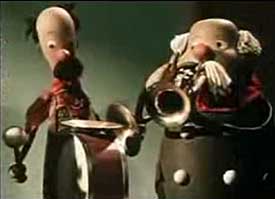 Each time the king goes through this process, he weeps copious tears for the beheaded barbers, but the secret of his ears must be kept. Each time the king goes through this process, he weeps copious tears for the beheaded barbers, but the secret of his ears must be kept.
The day comes when a certain young barber is chosen. It so happens that at the very moment he was selected, he was dressing the hair of the executioner. So he tied the executioner to the barber seat & then set off to trim the beard. Behaving with nonchallance, he afterward dawdles about the throne acting like he doesn't know why the executioner failed to arrive to take him away.
Given this unexpected delay, the king, who always grieved on the occasion, decides to give the barber a medal instead of a beheading, the medal serving as bribe never to mention the enormity of the king's donkey ears.
The whole village is surprised to see the young man rewarded rather put on the chopping block. And the young barber finds himself unexpectedly haunted by visions of the king's ears. He has nightmares of an actual jackass enthroned as king.
As an "insider" in-the-know, the barber is invited to the king's Christmas banquet, where joy is had by all, except the poor depressed barber who can barely eat or appreciate the musicians.
The king, however, responds to the double-bass player as he responds to braying donkeys. His ears pop up, knocking the crown off his head, & everyone at the banquet sees his deformity, including the peasant musicians who are in consquence marched out of the banquet room while the king hides under the table.
Very few of the courtiers knew of the king's deformity but now they have all seen it. At this point the barber, never desirous of being a favorite, throws down his medal & leaves the banquet hall, though beats the heck out of me what his problem is.
Zeman has been called "the Walt Disney of Czechlosovakia." This is actually more insulting than it sounds, because the greatest Czech puppet animator was Jiri Trnka who was recognized as a serious animator who completely broke with the childish Disney orientation & made sophisticated films of great artistry. Zeman by contrast made magical kiddy films.
King Zavra was not all that impressive to me as it never overcame its cuteness, is pitched exclusively to kids, & I really couldn't make sense of the story because why in the world did the young barber suffer angst over the king's ears & for climax throw the king's favors back at him with insulting disdain?
It's kind of like if the story of Rudolf the Rednose Reindeer had ended with all the other reindeers abusing & rejecting him even more. And even as a kiddy flick it seems the king should've just gotten over his insecurity & become a better king, but Zeman's story goes for the lame political content that kings at heart really are jackasses.
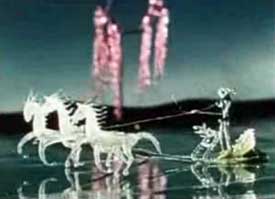 In one of the most amazing stop motion animated shorts ever made Inspirace (Inspiration, 1948) was created from blown-glass figurines that were re-heated & re-heated to reposition for the stop-motion cameras.
In one of the most amazing stop motion animated shorts ever made Inspirace (Inspiration, 1948) was created from blown-glass figurines that were re-heated & re-heated to reposition for the stop-motion cameras.
The fragility of these figurines would seem to make the method impossible, & yet here they have sprung to life, a fabular world where glass, & rainwater, are one.
A young glassblower gazing at a window down which rainwater slides begins to perceive or imagine life in a single drop of water clinging to a leaf. Miniscule glass fish swim through glass filaments of aquatic plantlife.
Glass bubbles rise from out of a scallop to the surface of the water, & burst into waterlilies. A blown glass ballerina spins along the water's surface., then skates along like a water-strider, past an iceflow ridden by watchful pengins, between glass swans, under branches of glass willows.
A single dandilion seed parachutes into the water drop & transforms into a pierot-like dancing figure that joins the glass ballerina with loving devotion, only to find himself divided from her by a partition of ice. Sadness bursts from him & breaks a doorway through the ice, & he drifts upon a shard of ice through a mirrored world of dream.
Delicate glass horses draw a swan-chariot, driven by the ballerina cum charioteer. But before she & the dandylion can be united, the waterdrop slips from the leaf into a pool, & a tiny world is no more.
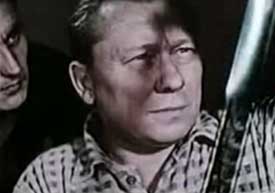 The clips used in The Special Effects of Karel Zeman (1980) are from his films made between 1947 & 1980. The short quarter-hour documentary is a pleasing introduction to his works, with special focus on the FX.
The clips used in The Special Effects of Karel Zeman (1980) are from his films made between 1947 & 1980. The short quarter-hour documentary is a pleasing introduction to his works, with special focus on the FX.
This documentary begins with a very sophisticated piece of science fiction, with gorgeously designed space ships, & a cosmonaut walking on the surface of a blasted planet -- toward a wind-up victrola, a most curious filmic image.
We see mostly clips but on several occasions we're permitted to see the illusion broken down into "how it is done."
For the The Fabulous World of Jules Verne (Vynalez Zkazy, 1958), we see what appear to be Victorian woodcuts of extraordinary inventions rendered three-dimensional & real, but still with the impact of those old wood engravings. It's occasionally startling to learn that Zeman has taken his three-dimension puppetry & intentionally made it look like two-dimensional book plates from very early Verne editions.
We also see samples of Zeman's less interesting children's animation. It's nostalgic value is lacking for viewers who didn't grow up on Czech children's entertainment, & the kidfilms are truly only for kids.
The Special Effects of Karel Zeman is unusually superficial, but as a collection of clips with a few behind-the-scenes peaks at methods, it's a cohesive little homage.
copyright © by Paghat the Ratgirl
|
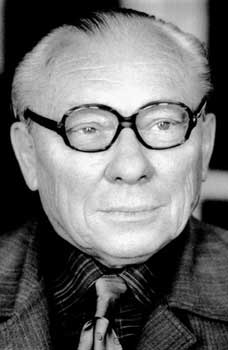

 Each time the king goes through this process, he weeps copious tears for the beheaded barbers, but the secret of his ears must be kept.
Each time the king goes through this process, he weeps copious tears for the beheaded barbers, but the secret of his ears must be kept.
